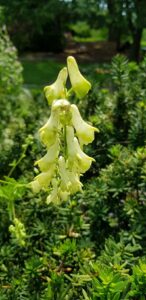How to Propagate Aconitum krylovii

Propagating Aconitum krylovii: A Gardener’s Challenge
Introduction:
Aconitum krylovii, also known as Krylov’s Monkshood, is a striking member of the Ranunculaceae family, captivating gardeners with its tall, elegant spires of intensely colored flowers, often deep blue or purple. This relatively rare species holds a special place in the hearts of plant enthusiasts, adding a touch of the exotic to borders and shady gardens. Its propagation, however, presents unique challenges, making successful cultivation a rewarding accomplishment. Its attractiveness, combined with its challenging propagation, contributes to its popularity among those seeking a horticultural test of skill.
Seed Germination:
Currently, there are no known reliable methods for seed germination propagation of Aconitum krylovii. The seeds of many Aconitum species exhibit dormancy and require specific conditions for germination, which haven’t been successfully established for Aconitum krylovii. Further research into optimal stratification techniques and germination media is needed before seed propagation can be considered a viable option.
Cuttings:
Propagating Aconitum krylovii from cuttings presents some challenges but also offers potential for success.
Challenges: Aconitum cuttings are notoriously difficult to root. The success rate is significantly influenced by the timing of the cutting (ideally taken from young, actively growing stems in early summer), the use of rooting hormone, and maintaining consistently high humidity and moderate temperatures.
Practical Tips: Take semi-hardwood cuttings, approximately 10-15cm long, with a sharp blade, ensuring a clean cut. Remove lower leaves to prevent rotting. Dip the cut end in a rooting hormone powder and plant in a well-draining propagating mix kept consistently moist but not waterlogged. Cover the cuttings with a clear plastic dome or propagator to maintain humidity.
Rewards: Cuttings offer a faster propagation method than division, allowing the creation of multiple plants from a single mother plant while maintaining the exact genetic characteristics.
Division:
Division is a more reliable method for propagation than seed germination or cuttings.
Challenges: Aconitum krylovii, like many perennials, has a relatively limited period for successful division, usually during the dormant season (late autumn or early spring). Care must be taken to avoid damaging the fragile roots. Each division must boast sufficient root material for successful re-establishment.
Practical Tips: Carefully dig up the established plant, ensuring as much of the root system is intact as possible. Divide the plant into sections, each with several shoots and a healthy root system. Replant the divisions immediately in well-prepared soil, ensuring adequate spacing.
Rewards: Division is relatively straightforward, guaranteeing a high success rate if done correctly and offering a quick way to increase the number of plants.
Tissue Culture:
Tissue culture offers the potential for large-scale propagation of Aconitum krylovii, overcoming the limitations of other methods.
Challenges: Establishing a successful tissue culture protocol for Aconitum krylovii requires specialized knowledge, equipment, and a sterile environment. This method is not suitable for the average home gardener. Finding suitable, sterile media and developing effective sterilization processes for the plant material are important considerations.
Practical Tips: This method is best left to experienced tissue culture laboratories with the appropriate facilities.
Rewards: Tissue culture allows for rapid multiplication of genetically identical plants, providing a means for large-scale propagation and conservation efforts if there are concerns about the plant’s population in the wild.
Conclusion:
Propagating Aconitum krylovii presents a unique horticultural challenge, with seed germination currently proving unreliable. Division offers the most accessible and reliable method for home gardeners, while cuttings, though challenging, hold promise. Tissue culture provides the means for larger-scale propagation but demands specialized skills and facilities. The rewards of successfully cultivating this stunning plant – its unique beauty and the satisfaction of mastering a challenging propagation process – far outweigh the difficulties encountered along the way. For aspiring propagators, patience, attention to detail, and a willingness to experiment are key to unlocking the secrets of successfully growing this exceptional monkshood.